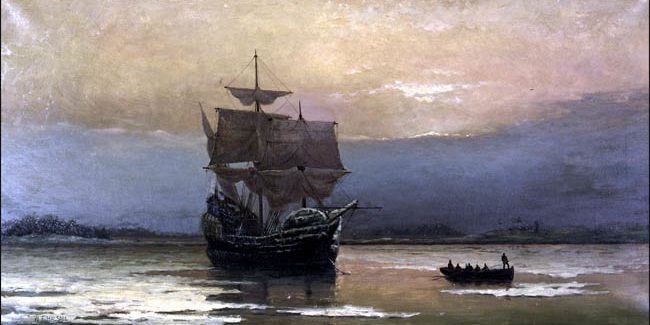Forefathers Day, the day the Pilgrims stepped on Plymouth Rock, is an original American holiday. It predates the official celebration of Independence, Thanksgiving and Christmas as a part of American culture. The landing of the Pilgrims in Plymouth, however, was the culmination of a month of exploration on Cape Cod.
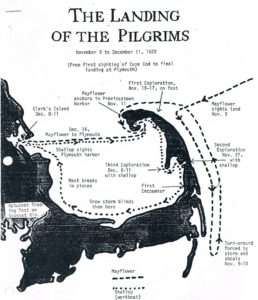 After the passengers on board signed the Compact on Saturday November 11, had their church service on Sunday the 12th and made their initial landing in Provincetown on Monday the 13th, they spent the next four weeks exploring, seeking a place to settle. They were looking for a tract of abandoned (and cleared) land, fresh water, a shallow harbor, and a high hill. During their explorations they found no place on Cape Cod that had all four of these ingredients.
After the passengers on board signed the Compact on Saturday November 11, had their church service on Sunday the 12th and made their initial landing in Provincetown on Monday the 13th, they spent the next four weeks exploring, seeking a place to settle. They were looking for a tract of abandoned (and cleared) land, fresh water, a shallow harbor, and a high hill. During their explorations they found no place on Cape Cod that had all four of these ingredients.
Their third exploration began on Wednesday, December 6. Early in the morning on the 8th they were attacked by the Nauset tribe interrupting their devotions on the beach. The Nauset had good reason to attack as an act of self-defense since six years before, they had been robbed of over 20 of their braves by Englishman Thomas Hunt who took them as slaves to Europe. Though no one was hurt in the skirmish, it caused the Pilgrims to sail further, looking for a place to settle and this would prove Providential.
As the Pilgrims’ diary relates; “… It began to snow and rain… about the midst of the afternoon the wind increased, and the seas began to be very rough; and the hinges of the rudder broke, so that we could steer no longer with it, but two men, with much ado, were fain to serve with a couple of oars. The seas were grown so great that we were much troubled and in great danger; and night grew on. Anon, Master Coppin bade us be of good cheer; he saw the harbor.” (This was probably the borders of Manomet and Plymouth harbor.) “As we drew near, the gale being stiff, and we bearing great sail to get in, split our mast in three pieces, and were like to have cast away our shallop. Yet, by God’s mercy, recovering ourselves, we had the flood (tide) with us, and struck into the harbor.”
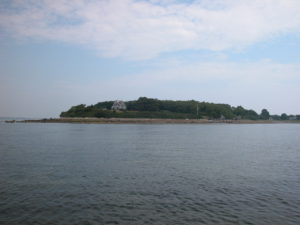
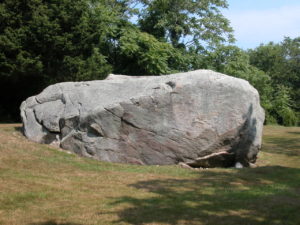 “Yet still the Lord kept us, and we bare up for an island before us; and recovering of that island, being compassed about with many rocks, and dark night growing upon us, it pleased the Divine Providence that we fell upon a place of sandy ground, where our shallop did ride safe and secure all that night; and coming upon a strange island, kept our watch all night in the rain upon that island. And in the morning we marched about it, and found no inhabitants at all; and here we made our rendezvous all that day, being Saturday.” While some of the men repaired the shallop (their smaller, open boat), the rest of the 18 weary men presumably gathered near the large boulder at the center of the island to dry their clothes.
“Yet still the Lord kept us, and we bare up for an island before us; and recovering of that island, being compassed about with many rocks, and dark night growing upon us, it pleased the Divine Providence that we fell upon a place of sandy ground, where our shallop did ride safe and secure all that night; and coming upon a strange island, kept our watch all night in the rain upon that island. And in the morning we marched about it, and found no inhabitants at all; and here we made our rendezvous all that day, being Saturday.” While some of the men repaired the shallop (their smaller, open boat), the rest of the 18 weary men presumably gathered near the large boulder at the center of the island to dry their clothes.
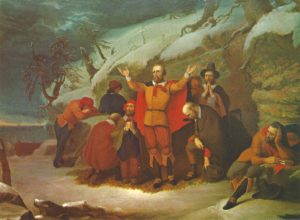 Today that large boulder near the center of the island is called Pulpit Rock. It is much larger than Plymouth Rock, and can symbolize the religious liberty of conscience in the hearts of these Pilgrims. The Pilgrims were ready to land on Sunday but would not explore on the Lord’s Day. Thus, Pulpit Rock repres
Today that large boulder near the center of the island is called Pulpit Rock. It is much larger than Plymouth Rock, and can symbolize the religious liberty of conscience in the hearts of these Pilgrims. The Pilgrims were ready to land on Sunday but would not explore on the Lord’s Day. Thus, Pulpit Rock repres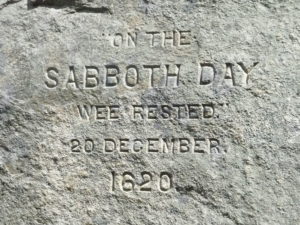 ents their convictions, drawn from the Bible, that put their spiritual responsibilities to God ahead of deciding on a place to settle. Here they conducted their first church service on land in the new world. Their diary states “10th of December. On the Sabbath day we rested.” The inscription on Pulpit Rock reads “On the Sabboth Day wee rested 20 December 1620.”
ents their convictions, drawn from the Bible, that put their spiritual responsibilities to God ahead of deciding on a place to settle. Here they conducted their first church service on land in the new world. Their diary states “10th of December. On the Sabbath day we rested.” The inscription on Pulpit Rock reads “On the Sabboth Day wee rested 20 December 1620.”
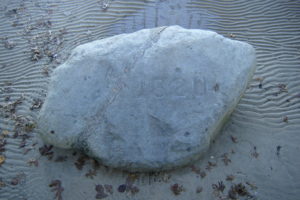 Bradford relates “On Monday they sounded the harbor and found it fit for shipping, and marched into the land and found divers cornfields and little running brooks, a place (as they supposed) fit for situation. At least it was the best they could find, and the season and their present necessity made them glad to accept of it. So they returned to their ship again with this news to the rest of their people, which did much comfort their hearts.” It was Monday, December 11 when they first landed in Plymouth. Though no mention of a rock is given, an eyewitness account of Thomas Faunce whose father heard it from William Bradford confirmed its identity in 1745. They did find all four ingredients – a high hill, cleared (and abandoned) land, fresh-water spring and a shallow body of water for their shallop.
Bradford relates “On Monday they sounded the harbor and found it fit for shipping, and marched into the land and found divers cornfields and little running brooks, a place (as they supposed) fit for situation. At least it was the best they could find, and the season and their present necessity made them glad to accept of it. So they returned to their ship again with this news to the rest of their people, which did much comfort their hearts.” It was Monday, December 11 when they first landed in Plymouth. Though no mention of a rock is given, an eyewitness account of Thomas Faunce whose father heard it from William Bradford confirmed its identity in 1745. They did find all four ingredients – a high hill, cleared (and abandoned) land, fresh-water spring and a shallow body of water for their shallop.
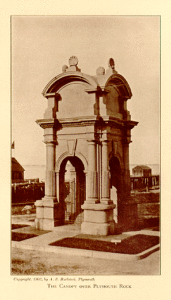 Forefathers Day was first celebrated by the Old Colony Club on December 22, 1769. The change in calendar caused them to add eleven days, though later they realized that only 10 was necessary. So here in Plymouth, we celebrate Forefathers Day two days in a row – the 21st by the Pilgrim Society (formed in 1820) and the 22nd by the Old Colony Club!
Forefathers Day was first celebrated by the Old Colony Club on December 22, 1769. The change in calendar caused them to add eleven days, though later they realized that only 10 was necessary. So here in Plymouth, we celebrate Forefathers Day two days in a row – the 21st by the Pilgrim Society (formed in 1820) and the 22nd by the Old Colony Club!  Hammatt Billings erected the first canopy over the Rock under the auspices of the Pilgrim Society in 1867, and then the present canopy was constructed in time for the 300th anniversary in 1920. Today, tourists from all over the world come to see a small rock under a Greek canopy stepped on by Englishmen whose Christian beliefs are based on their Jewish Roots!
Hammatt Billings erected the first canopy over the Rock under the auspices of the Pilgrim Society in 1867, and then the present canopy was constructed in time for the 300th anniversary in 1920. Today, tourists from all over the world come to see a small rock under a Greek canopy stepped on by Englishmen whose Christian beliefs are based on their Jewish Roots!
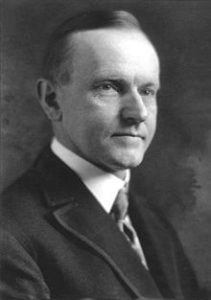 On December 21, 1920, Vice-President elect Calvin Coolidge spoke in Plymouth at the 300th anniversary of Forefathers Day. He closed his short remarks with these words “Plymouth Rock does not mark a beginning or an end.
On December 21, 1920, Vice-President elect Calvin Coolidge spoke in Plymouth at the 300th anniversary of Forefathers Day. He closed his short remarks with these words “Plymouth Rock does not mark a beginning or an end. 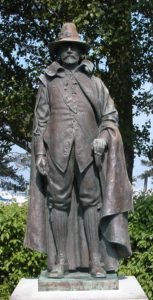 It marks a revelation of that which is without beginning and without end – a purpose, shining through eternity with a resplendent light, undimmed even by the imperfections of men; and a response, an answering purpose, from those who, oblivious, disdainful of all else, sailed hither seeking only for an avenue for the immortal soul.” Bradford said it well that their primary purpose was “a great hope and inward zeal they had, or at least to make some way thereunto, for the propagating and advancing the gospel of the kingdom of Christ into those remote parts of the world; yea, though they should be but even as stepping-stones unto others for the performing of so great a work.”
It marks a revelation of that which is without beginning and without end – a purpose, shining through eternity with a resplendent light, undimmed even by the imperfections of men; and a response, an answering purpose, from those who, oblivious, disdainful of all else, sailed hither seeking only for an avenue for the immortal soul.” Bradford said it well that their primary purpose was “a great hope and inward zeal they had, or at least to make some way thereunto, for the propagating and advancing the gospel of the kingdom of Christ into those remote parts of the world; yea, though they should be but even as stepping-stones unto others for the performing of so great a work.”

